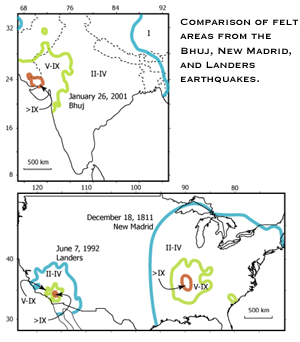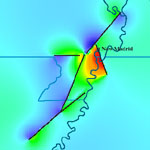 |
|
The Bhuj earthquake occurred about 400 to 600 km away from the nearest plate boundary . Strong-ground motion was felt over a region from Madras to Katmandu and Calcutta, distances of over 2000 km and more than 16 times that of the M 7.8 1906 San Francisco earthquake. These observations alone have prompted the suggestion that the Bhuj earthquake is analogous to the New Madrid earthquakes. If such an analogy is appropriate, the Bhuj earthquake offers an unparalleled and for all practical purposes, a unique opportunity to better quantify seismic hazard in both the continental USA and the subcontinent of India.
We are tackling these issues in a variety of ways, aside from the many seismological investigations that are currently underway by CERI personnel. One approach is to explore the consquence of ruptures on the distribution of uplift and subsidence of the region; can we make sense of the subtle topographic signatures in the region? Paleoseismological field investigations are being carried by Eugene Schweig (USGS in Memphis), Martitia Tuttle, and colleagues in the Department of Earth Sciences.
|
|

